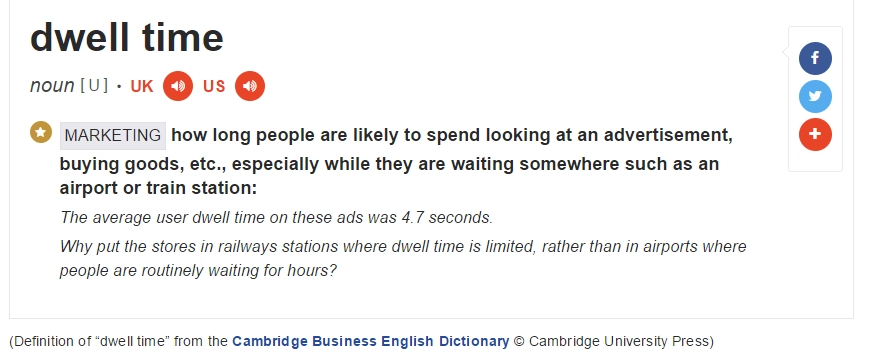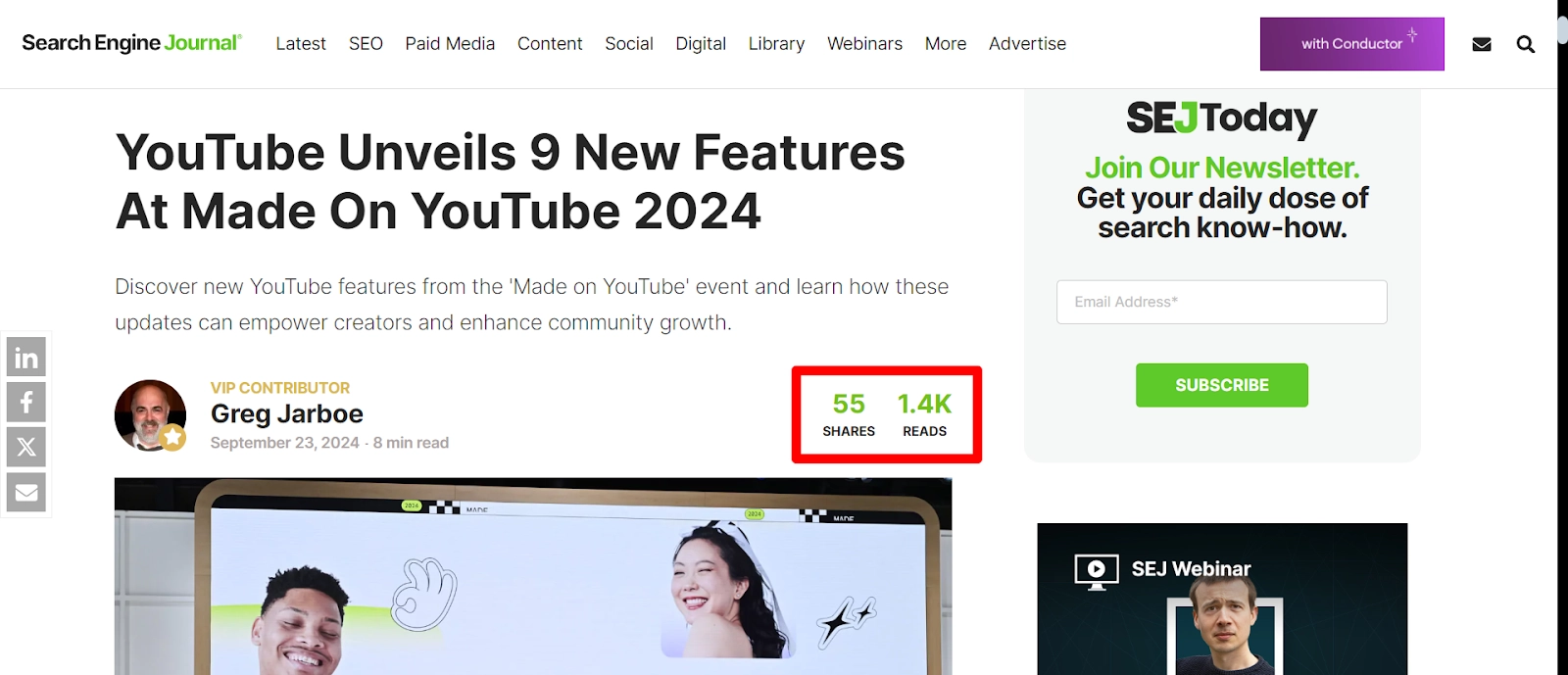What is Dwell Time?

Dwell time is a digital marketing metric that measures how long visitors stay on a particular webpage. It sounds simple but has a lot of relevance in the analysis of user engagement and website performance. Dwell time refers to the period of active engagement of a visitor with the site’s content before leaving.
A high dwell time indicates that visitors are finding your content valuable, interesting, and engaging. This is a positive sign, as it suggests that your website is meeting the search intent of the audience. Conversely, a low dwell time might signal that your content is not resonating with visitors or that there are issues with your website’s user experience.
Why is Dwell Time Important?
The reason is simple. The more users stay on your site, the more engagement you receive. And the higher the engagement, the more search engines will prioritize your site. Here’s a breakdown showing why exactly dwell time is important.
Improved User Experience
At the heart of successful digital marketing is a focus on the user experience. Visitors typically stay on a particular page for a long time when the content is meaningful and interesting to them. Such an effect is good as it helps to enhance customer satisfaction and loyalty and even increases the likelihood of a return visit. Optimizing dwell time helps brands craft pages that appeal to their target audience and foster a long-term relationship with them.
Higher Search Engine Rankings
Search engines like Google prioritize websites that provide a positive user experience. Dwell time is one of the key factors considered by search algorithms to determine a website’s relevance and quality. When users spend an extended period of time on a particular page, it indicates to search engines that the page holds helpful information. Consequently, when it comes to search results, websites with higher dwell times tend to rank better on search engine results pages, boosting the visibility and organic traffic they receive.
Increased Conversions
The dwell time on a page is super-important in increasing the chances of conversions – be it a successful sale, signing up for the newsletter, or completing a contact form. The more time visitors spend on a particular page, the more interested they are in the page and the more likely they are to take action. So, by making sure the visitors spend more time engaging with the site, you can develop more convincing web pages that can turn visitors into clients.
Enhanced Brand Reputation
A positive user experience directly impacts a brand’s reputation. When the users are favorably inclined, they tend to promote it and associate the brand with quality, reliability, and value. Generally, high dwell time is instrumental in maintaining a positive brand image, which helps in winning the trust and confidence of the target market. A strong brand image also leads to increased customer loyalty, advocacy, and ultimately, long-term business success.
Strategies to Increase Dwell Time
Here are some effective strategies to enhance dwell time.
Content Quality
Content is king, and you need to give it a royal and quality treatment. Produce content that is informative, interesting, and relevant to your target audience. Use clear and concise language, avoid technical jargon, and structure your content in a logical manner. Your end goal should be to make your content easy to understand while ensuring it fulfills the search intent.
But creating content is the first step of the journey. Optimization comes next, which is equally vital. Use headings, subheadings, and bullet points to break up your text and make it easier to read. Choose a font and font size that is easy on the eyes and avoid excessive clutter on the page. The idea is to make the content easy to scan.
Finally, you need to ensure you’re incorporating relevant keywords throughout your content to improve search engine visibility. You can perform a keyword research audit for this before selecting the keywords. Adding the right keywords will boost your chances of ranking on multiple search terms and drive traffic. However, avoid keyword stuffing, as it can negatively impact the user experience.
User Experience
User experience has always been key to better engagement, and the advent of metrics like Core Web Vitals has made it crystal clear. There are several measures you can take to enhance the user experience on your website, such as improving website speed. Slow loading times can frustrate visitors and drive them away. Optimize your website’s images, code, and hosting to ensure it loads quickly. Try to keep your load time under 2 or 3 seconds. Exceeding this range will push your website to the second page of search results that no one visits.
Also, focus on optimizing for mobile devices. With the increasing popularity of smartphones and tablets, it’s essential to have a mobile-friendly website. Ensure your site is responsive and adapts to smaller screen sizes.
Make it easy for visitors to find the information they are looking for. Use a clear and intuitive navigation menu and provide breadcrumbs to help users understand their location on the site.
Visual Elements

Compared to reading, people remember the information for a longer period if they see it. That’s where visual elements come in. Visual content can help break up your text and make your content more engaging. You can use high-quality images and videos that are relevant to your topic.
Also, ensure you have a visually appealing website design that is consistent with your brand. Use a color palette that is easy on the eyes, and ensure your website is well-organized and easy to navigate. A well-designed website doesn’t just look good; it also induces a sense of credibility towards the brand.
Social Sharing

Make it easy for visitors to share your content on social media. Include share buttons prominently on your website, and encourage social sharing in your content. More social visibility can lead to more referral traffic to your landing pages and a higher dwell time. You can also display social proof, such as likes, shares, and comments, to show that your content is popular and credible. This motivates new users to share your content as they see that people are already doing so.
Call to Action
Include clear and compelling calls to action. Guide visitors toward the desired action, whether it’s making a purchase, signing up for a newsletter, or contacting you. Use strong, action-oriented language and place your calls to action prominently on your website.
Measuring and Analyzing Dwell Time
Measuring dwell time is a relatively straightforward process, but it requires a keen eye, the right tools, and techniques. Here’s a breakdown of how to analyze and calculate dwell time effectively.
Tools for Measuring Dwell Time
When it comes to analysis, there are several tools, like Google Search Console, Google Analytics, etc., that give you an idea about dwell time. Here are some of the best ones to use.
- Google Analytics: This popular web analytics tool provides detailed insights into user behavior, including dwell time. Google Analytics can track time on the page, bounce rate, and other relevant metrics.
- Heatmap Tools:Heatmap tools visualize user interactions on a webpage, showing where users click, scroll, and spend the most time. Examining the heat maps can help identify areas of interest and sections that are confusing or difficult for users to navigate.
- Sessions Recording Tools: Sessions recording tools capture user interactions on your website, allowing you to watch videos of how visitors interact with your content. Watching these interactive sessions provides valuable insights into user behavior and identifies what users do on your page and what turns them off.
Analyzing Dwell Time Data
Once you’ve collected dwell time data, it’s important to analyze it carefully to understand the implications for your website. Let’s look at some key factors to consider.
- Average Dwell Time: Compare your page’s average dwell time to industry benchmarks or competitors to see how your website stacks up. For reference, the average dwell time benchmark lies between 2 and 4 minutes. A higher average dwell time generally indicates a more engaging user experience.
- Bounce Rate: A high bounce rate indicates that visitors are leaving your site after viewing only one page, which can be a sign of poor user experience or irrelevant content.
- Exit Rate: The exit rate measures the percentage of visitors who leave your site from a particular page. A high exit rate for a specific page indicates that the content does not meet the needs of visitors on that page.
- Time on Site: The total time visitors spend on your website can also be a valuable metric. A longer time on site suggests that visitors are finding your content engaging and informative.
- Average Session Duration: The total time a visitor spends on your site during a single visit. This works for the overall site as well as a particular page. So, track the average session duration to find out how good your site is at compelling visitors.
Conclusion
At the end of the day, everyone wants conversions. You don’t want visitors only to read your blogs or browse your products and leave without buying. And dwell time is something that drives visitors to conversions. So keep an eye on your site’s dwell time. If it doesn’t meet the benchmarks, employ the right practices to improve it. The longer you engage visitors, the more likely they’ll take action.







